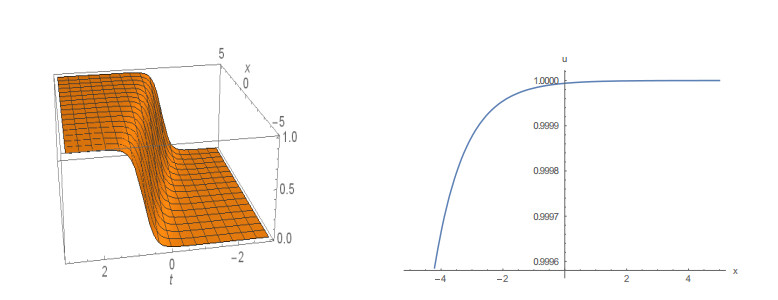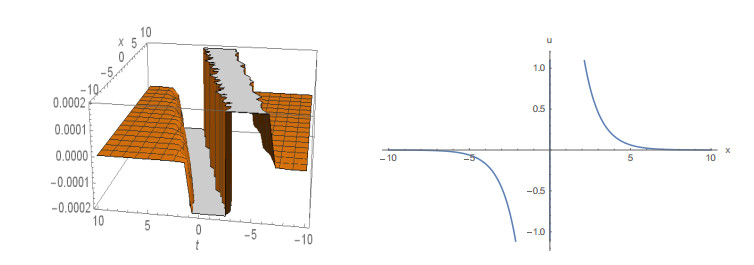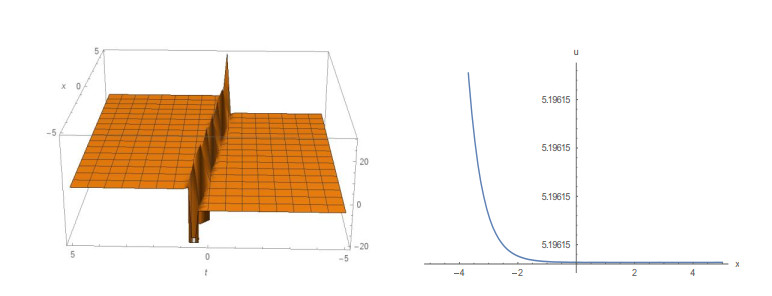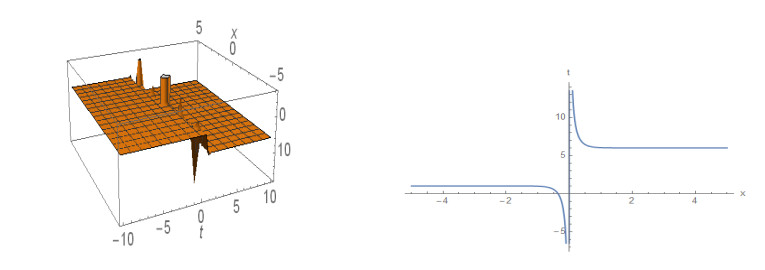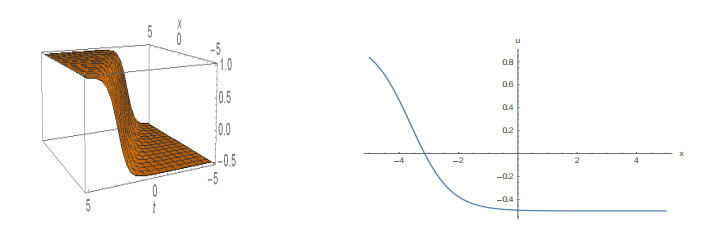In this work, we construct closed form traveling wave solutions to some nonlinear evolution equations (NLEEs) associated with mathematical physics. This work implements the well-established generalized Kudryashov method (gKM) to compute new closed form traveling wave solutions to the Burgers-Huxley equation, the mKdV equation and the first extended fifth order nonlinear equation. Furthermore, in this investigation, we discuss the achieved results in details and portrayed some 2D and 3D figures with the aid of symbolic computation package like Mathematica. The worked-out results ascertained that the suggested generalized form of the Kudryashov method is a simple, efficient and reliable technique to deal with other kinds of NLEEs.
1.
Introduction
Nonlinear evolution equations (NLEEs) attracted much attention in a wide variety of scientific analysis in various fields of applied science and engineering. The nonlinear complex physical phenomena are related to NLEEs which play a significant role in many attributions: especially in nonlinear optics, electric control theory, solid-state physics, nuclear physics, high energy physics, mathematical biology, biochemistry, chemically reactive materials, biophysics, optical fibers, fluid mechanics, plasma physics etc. Since the modeling of real world problems are essentially nonlinear, it is necessary to extract their exact, approximate or numerical solutions. Due to the availability of high performance computer facilities and symbolic computation software like Mathematica, the task of handling computational methods to acquire exact solutions of NLEEs is very fascinating for many scholars. For this reason, in the last decades, a number of potential methods have been formulated and implemented to search exact solution, such as the homogeneous balance method [1], the modified simple equation method [2], the F-expansion method [3,4], the sine-Gordon equation expansion method [5,6,7], the (G'/G)-expansion method [8], the modified exponential function method [9], the tanh method [10], the sine-cosine method [11,12], the (G'/G, 1/G)-expansion method [13,14,15], the new extension of (G'/G)-expansion method [16], the tanh-coth method [17], the generalized bilinear operator method [18,19,20], the Exp-function method [21], the modified tanh-function method [22], the extended tanh method [23], the Hirota's bilinear method [24,25,26,27], the exponential rational function method [28], Jacobi elliptic function method [29], the improved (G'/G)-expansion method [30], the Bernoulli sub-equation function method [31], the improved Bernoulli sub-equation function method [32], the generalized Riccati equation method [33], the finite difference method [34,35,36], the modified Kudryashov method [37,38,39,40,41,42] and others are developed to extract wave solutions of NLEEs.
Recently, the generalized Kudryashov method [43,44,45,46,47,48] was introduced to examine the NLEEs modeled the physical problems. The main objective of this article is: we introduce and implement the originative method, named the generalized Kudryashov method to establish new closed form traveling wave solutions to some NLEEs, viz. the Burgers-Huxley, the mKdV and the first extended fifth order nonlinear equations. To the best of our comprehension no one studied the aforesaid equations through the generalized Kudryashov method.
The Burgers-Huxley equation is of the form [49]:
The mKdV equation is of the form [50]:
The first extended fifth order nonlinear equation is of the form [51]:
The Burgers-Huxley equation can be considered as a model to relate the interaction between reaction mechanisms, convection effects and diffusion transports [52]. Many physical applications of mKdV equation, first extended fifth order nonlinear equation and is used as a model for nonlinear dispersive waves.
The remainder of this article contains the following portions: In section 2, recapitulation of the generalized Kudryashov method is briefly described. In section 3, applications of the method to some NLEEs, as for example, the Burgers-Huxley equation, the mKdV equation and the first extended fifth order nonlinear equation are provided. Physical assertion and graphical illustration is presented in section 4. Finally, in section 5, conclusions are provided.
2.
General structure of the generalized Kudryashov method
We assume the NLEEs for a function u(x, t) of two variables x and t as follows:
where P being a polynomial of u and its partial derivatives in which the nonlinear terms and the highest order derivatives are engaged. The procedures of the generalized Kudryashov method [43,44,45,46,47,48] are given in briefly as follows:
First Step
First, we consider the following wave variable for reducing the NLEE (4) to an ordinary differential equation (ODE)
where k is the wave number and v indicates the wave velocity. Therefore, the Eq. (4) moves to the subsequent ODE,
wherein prime " ' " indicates the ordinary derivative in terms of η.
Second Step
As per the gKM, the exact solution of Eq. (6) can be presented as [38,39,40]
where ai, bj are arbitrary constants with aN≠0, bM≠0 to be calculated later and R(η) is the solution of the auxiliary equation
The solution of Eq. (8) has the following form
where A is the constant of integration.
Third Step
The homogeneous balance principle provides the values of positive integers M and N from Eq. (6) by using the highest order derivative and nonlinear term.
Fourth Step
In order for calculating the constants ai and bj, insert Eq. (7) into Eq. (6) and by means of Eq. (8) yields a polynomials of R(η). Equalizing these coefficients to zero offers a system of algebraic equations. Mathematica software package program is used for solving this system of equations to find out the constants as we desired. Finally, these constants provided the new closed form traveling wave solutions to the NLEE (4).
3.
Formulation of the solutions
In this section, the generalized Kudryashov method has been conducted to study the new closed form traveling wave solutions to the mentioned equations.
3.1. The Burgers-Huxley equation
Within this subsection, we implement the gKM to establish the closed form traveling wave solution to the Burgers-Huxley equation (1). The following transformation is considered
where c is a wave velocity. Substituting the transformation (10), Eq. (1) turns out to be
wherein " ' " stands for ddη. By the homogeneous balance principle from Eq. (11), we attain
M is free parameter, therefore, if we set M = 1, it yields N = 2.Thus, solution (7) moves to
where a0, a1, a2, b0, b1 are constants and R(η) obtain from (8). By the gKM the following system of equations are produces,
Solving above set of equations by using Mathematica, we obtain two sets of values of the constants and by means of these values the required solutions can be found.
Set 1:
Inserting the above values into solution (13), the exact solution of Eq. (1) takes the shape
Since A is the integral constant, one might randomly choose its values, thus if we choose A = 1, the above solution transforms to the subsequent simplest form
Again, if we choose A = -1, the solution takes the form
The other choice of the value of A produces many further general form solutions to the Burgers-Huxley equation, but for conciseness the rest of the solutions are not documented.
Set 2:
For set 2, the exact solution of Eq. (1) becomes
If we set A = 1, the above solutionis simplified as
Again, if we set A = -1, the solution converts to
The other selection of the estimation of A produces various extensive wave solution to the Burgers-Huxley equation, yet for succinctness whatever remains of the arrangements are not reported.
3.2. The mKdV equation
In this subsection, we will derive the exact solutions to the mKdV equation by the eminent method and for this application we consider the same traveling wave transformation as given in Eq. (10). Plugging in this transformation and integrating once with zero constant, Eq. (2) turns out to be
where δ > 0 and by homogeneous balance principle between highest order derivative and nonlinear term in the above equation, as before we consider the Eq. (13) is the solution of Eq. (22).
In order to find out the constants a0, a1, a2, b0, b1, appearing in (13), we use the generalized Kudryashov method and by using package program Mathematica for solving the system of equations gives different sets of values and by means of these values the desired closed form traveling wave solutions of Eq. (2) can be derived.
Set 1:
Inserting these values in solution (13), the exact solution of Eq. (2) becomes
For as much as A is constant of integration, one might choose its values arbitrarily. In particular, when A = ±1, the above solution converts into following form
Set 2:
By means of these values from solution (13), the exact solution of Eq. (2) is obtained as
In as much as A is arbitrary constant, one may pick its values subjectively. Specifically, when A = 1, the above arrangement changes over into the following structure
Again, when A = -1, the solution becomes
Set 3:
For the above values of the constants the exact solution of Eq. (2) turns out to be
In particular, if we choose A = ± 1, we obtain the solution
Again, we select A = -1, the same solution will be attained and hence has not been written down.
3.3. The first extended fifth order nonlinear equation
In this subsection, we extract the wave solutions to the first extended fifth order nonlinear Eq. (3) by the introduced eminent method and to this end we consider the subsequent wave transformation
By means of the above transformation the Eq. (3) is converted into
Integrating twice with respect to η and taking the integrating constant zero, Eq. (33) moves to the following form
The homogeneous balancing principle between highest order derivative and nonlinear term in the above equation as before, Eq. (13) is the solution of Eq. (35).Using the gKM and computer package program Mathematica the desired solutions of the associated algebraic equations are,
Set 1:
where a0 and b0 are an free parameters.
By using the above values into (13), the exact solution of Eq. (3) turns out to be
where, v=−k√1+4k2.
If we set A = ±1, the solution becomes
Set 2:
where a0, b0 and b1 are free parameters.
By using the values arranged in (39) into solution (13), the exact solution of Eq. (3) becomes
where, v=−k√1+k2.
In particular, if we pick A = 1, the above solution shrink to
On the other hand, if we pick A = -1, the solution is minimized as
Set 3:
wherein a1 and b1 are free parameters.
In this case, the exact solution of Eq. (3) becomes
where, v=−k√1+k2.
If we sort A = 1, the solution takes the form
Furthermore, if we sort A = -1,
4.
Physical significance and graphical representations
Now, we will study physical significance and graphical representation of the established solutions of the Burgers-Huxley equation, the mKdV equation and the first extended fifth order nonlinear equation. We obtain the solitary waves from the traveling wave solutions through assigning specific quantities to its indefinite parameters. By altering these parameters, one can get an internal localize mode. The solutions for the above referred equations that we have obtained include different types of soliton. Appropriate selection of parameters enables us to develop the soliton, kink, periodic, singular, discontinuous periodic, and the soliton-like solutions. Kink solitons have significant application prospects in optical fiber communication. Singular solitons are another sort of solitary waves that show up with a singularity, typically infinite discontinuity. Singular solitons can be associated with solitary waves when the midpoint position of the singular wave is nonexistent. Along these lines it isn't superfluous to address the issue of singular solitons. This solution has spike and in this manner can likely give a clarification to the development of Rogue waves.
The graphical illustrations of 3D plot and 2D plot of some obtained solutions are given in Figures 1 to 8. Figure 1, depicts the 3D plot and the corresponding 2D plot of solution (15) that behaves like the kink solution for k = 2 and A = 1 within the interval -5≤x, t≤5. Figure 2, also represents the kink shape soliton depicted from the solution (19) for k = -5, A = 1 within the interval -5≤x≤5 and -3≤t≤3. The solution (24) is represented in Figure 3, for A = -1 and δ = 3.5 within the interval -10≤x, t≤10. Figure 4, shows the 3D and the corresponding 2D plot of solution (27) represents the singular soliton for A = -1 and δ = 0.5 within the interval -10≤x, t≤10. Figure 5, depicts the profile of solution (31) that is soliton solution in 3D and the corresponding 2D for A = ±1 and δ = 4.5 within the interval -5≤x, t≤5. Figure 6, represents the singular soliton solution of solution (37) for a0 = 1, b0 = 1, K = -2.5 and A = ±1 within the interval -5≤x≤5 and -10≤t≤10. Figure 7, shows the profile of solution (39) which represents the shape of a singular kink soliton for a0 = 1, b0 = 1, b1 = 5, k = 1 and A = -1 within the interval -5≤x≤5 and -5≤t≤5. Also, Figure 8 represents the kink soliton of solution (44) in 3D and the corresponding 2D with a1 = 1, b1 = 1, k = 1.5 and A = 1 within the same interval.
5.
Conclusion
In this study, we constitute the exact solutions for a large category of nonlinear evolution equations by making use of the generalized Kudryashov method. The method has been effectively appointed to attain the exact solutions to the Burgers-Huxley, the mKdV and the first extended fifth order nonlinear equations. The obtained solutions are ascertained by setting them back into the said physical model and are observed to be very convenient over various existing methods. For the precision of the result, the solutions are graphically illustrated in 3D and 2D. The key advantage of this method against other methods is that the method provides more general and a large number of exact solutions in an identical way. The execution of this method is fruitful, effective, simple and reliable. Also, we emphasize that this method is very effectual and exigent from the theoretical and practical point of view. Moreover, it is also quite capable and can be implemented for attaining exact solutions of other nonlinear evolution equations in applied nonlinear science.
Conflict of interest
The authors declare no conflict of interests.










 DownLoad:
DownLoad:
